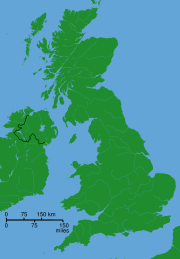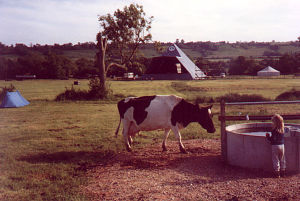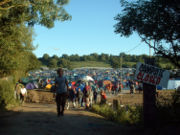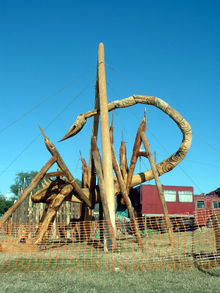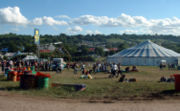Glastonbury Festival
2007 Schools Wikipedia Selection. Related subjects: Musical genres, styles, eras and events
| Glastonbury Festival | |
 |
|
| Location(s) | Pilton, England |
| Years active | 1970 - present |
| Date(s) | last weekend of June (3 days) |
| Genre(s) | Rock, Alternative rock, Indie rock, Dance, World music, Punk Rock, Reggae, Folk music. |
|
Map sources for Glastonbury Festival at grid reference ST590397
|
The Glastonbury Festival of Contemporary Performing Arts, commonly abbreviated to Glastonbury Festival or Glasto, is the largest greenfield music and performing arts festival in the world. The festival is best known for its contemporary music, but also features dance, comedy, theatre, circus, cabaret and many other arts. In 2005, the enclosed area of the festival was over 900 acres (3.6 km²), had over 385 live performances and was attended by around 150,000 people.
Originally Glastonbury was heavily influenced by hippy ethics and the free festival movement in the 1970s, especially the Isle of Wight Festival. Organiser Michael Eavis stated that he decided to host the first festival, then called Pilton Festival, after seeing an open air Led Zeppelin concert at the nearby Bath and West showground in 1970 . The festival retains vestiges of this tradition, including the Green Futures/Healing Fields area and the reputation for alternative culture.
Location
The festival takes place in South West England at Worthy Farm between the small village of Pilton and Pylle, six miles east of the town of Glastonbury, overlooked by the Glastonbury Tor in the mystical "Vale of Avalon". This makes it an important " New Age" area: many ley lines are believed to converge on the Tor. The nearest town to the festival site is Shepton Mallet, three miles north east, but there continues to be interaction between the people espousing alternative lifestyles living in Glastonbury and the festival itself. The farm is situated between the A361 and A37 roads.
Festival Site: Worthy Farm
Worthy Farm is situated (map) in a valley at the head of the Whitelake River, between two low limestone ridges, part of the southern edge of the Mendip Hills. On the site is a confluence of the two small streams that make the Whitelake River. In the past the site has experienced problems with flooding, though after the floods that occurred during the 1997 and 1998 festival, drainage was improved (see Timeline below). This did not prevent flooding during the 2005 festival, but allowed the floodwaters to dissipate within hours. The Bridgwater branch of the Somerset and Dorset Joint Railway ran through the farm on an embankment, but was dismantled in the late 1960s and now forms a main thoroughfare across the site. Another prominent feature is the high-voltage electricity line which crosses the site east-west.
In recent years the site has been organised around a restricted backstage compound, with the pyramid stage on the north, and other stage on the south of the compound. Attractions on the east of the site include the acoustic tent, comedy tent and circus. To the south are the green fields, which include displays of traditional and environmentally friendly crafts. In King's Meadow, the hill at the far south of the site, is a small megalith circle which, like Stonehenge, is coordinated with the summer solstice. Constructed in 1990 to simulate an ancient stone circle, the site has no actual archaeological interest .
The restricted-access backstage compound is populated almost entirely by bands and their support crews. Ironically, the backstage bar, Lulu's, is the cheapest bar at the festival, and hosts many charity functions and auctions.
Organisation
The festival is organised by local farmer and site owner Michael Eavis (through his company Glastonbury Festivals Ltd), who has hosted the event since its inception. Since 2002, the Mean Fiddler Music Group has taken on the job of managing the logistics and security of the festival through a 40% stake in the festival management company. Each year a company, joint owned by Glastonbury Festivals Ltd and Mean Fiddler Plc, is created to run the festival, with profits going to the parent companies. Glastonbury Festivals Ltd donates most of their profits to charities. The Mean Fiddler contract is a rolling one reviewed every five years.
Several stages and areas are managed independently, such as The Left Field which is managed by a cooperative owned by the Trades Union Congress , Radio Avalon and a field run by Greenpeace .
With the exception of technical and security staff, the festival is mainly run by volunteers. Stewards are organised by the aid charity Oxfam and the bars are organised by the Workers Beer Company, sponsored by Budweiser, who recruit teams of volunteer staff from small charities and campaign groups. In return for their help, typically around 18 hours over the festival, volunteers are paid in free entry, transport and food, while their charities are given donations by the organisers.
Catering, and some retail services, are provided by various small companies, typically mobile catering vans. The camping retail chain Millets, and many independent shops, set up makeshift outlets at the festival. Additionally many charities and organisations run promotional or educational stalls, such as the Hare Krishna vegetarian food stand. Network Recycling manage refuse on the site, and in 2004 recycled 300 tonnes and composted 110 tonnes of waste from the site .
Glastonbury over time
This section is largely based on A Brief History of the Glastonbury Festival .
1970s
The first festival, a small scale event of 1,500 people called the Pilton Festival, was created by Michael Eavis in 1970, followed by the larger scale Glastonbury Fayre of 1971, now also with the help of Andrew Kerr and Arabella Churchill. The 1971 festival featured the first incarnation of the "Pyramid Stage", built from scaffolding and metal sheeting. It was paid for by its supporters and advocates of its ideal, and took a medieval tradition of music, dance, poetry, theatre, lights and spontaneous entertainment. The 1971 festival was filmed by Nicolas Roeg and David Puttnam and was released as a film simply called Glastonbury Fayre. Although there were unofficial gatherings, the festival was not held again until an unplanned event in 1978, and a planned festival the following year which lost money. The festival has been an annual fixture since 1981, albeit with breaks in 1988, 1991, 1996, 2001 and 2006.
1980s
In 1981 the festival was organised with the Campaign for Nuclear Disarmament (CND). That year a new Pyramid Stage was constructed from telegraph poles and metal sheeting (ironically, ex- Ministry of Defence), a permanent structure which doubled as a hay-barn and cow-shed during the winter.
In the 1980s the children's area of the festival (which had been organized by Arabella Churchill and others) became the starting point for a new children's charity called Children's World. 1981 was the first year that the festival made profits, and Eavis donated £20,000 of them to CND. In the following years donations were made to a number of organisations, and since the end of the Cold War the main beneficiaries have been Oxfam, Greenpeace, and WaterAid who all contribute towards the festival by providing features and volunteers who work at the festival in exchange for free entrance.
Since 1983 large festivals have required licenses from local authorities. This led to certain restrictions being placed on the festival, including a crowd limit and times during which the stages could operate. The crowd limit was initially set at 30,000 but has grown every year to over 100,000. In 1985 the festival grew too large for Worthy Farm, but neighbouring Cockmill farm was purchased.
1985 was a wet festival with lots of rain. Worthy Farm is a dairy farm and what washed down into the low areas was a mixture of mud and liquified cow dung. This didn't prevent the festival-goers from wallowing in the knee-deep slurry in front of the pyramid stage.
1990s
1990 saw the biggest festival yet, however violence at the end of the festival between the security guards and new age travellers - the so-called Battle of Yeoman's Bridge - led to the organisers taking 1991 off to rethink the festival. The festival returned in 1992 with an expanded festival, which proved to be a great success. 1992 was the first year that the new age travellers were not allowed onto the site for free and a sturdier fence was designed. This success was carried through to 1993, which like 1992's festival was another dry, hot year.
In 1994 the Pyramid Stage burned down just weeks before the festival, a temporary main stage was erected in time for the festival. The 1994 festival also introduced a 150 kW wind turbine which provided some of the festival power. This festival also included the setting of a new world record on 26 June when 826 people, juggling at least three objects each, kept 2,478 objects in the air. This was also the year the festival was first televised by Channel 4, concentrating on the main two music stages it provided a glimpse of the festival for many who knew little of it. Channel 4 also televised the following year as well which also proved to be very successful.
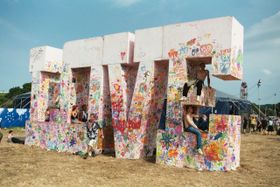
The following year saw the attendance rise drastically due to the security fence being breached on the Friday of the festival. Estimates suggest there may have been enough fence-jumpers to double the size of the festival. This aside, 1995 proved to be a highly successful year with memorable performances from Oasis, PJ Harvey, Jeff Buckley and The Cure. This was also the first year of the festival having a dance tent to cater for the rise in popularity of dance music, following the success of Orbital's headline appearance the previous year. The dance acts of 1995 were led by Massive Attack on the Friday and Carl Cox on the Saturday.
The festival took a year off in 1996 to allow the land to recover and give the organisers a break. This would be a pattern which would be followed every five years from now on. 1996 also saw the release of Glastonbury the Movie which was filmed at the 1993 and 1994 festivals.
The festival returned in 1997 bigger than ever. This time there was major sponsorship from The Guardian and the BBC, who had taken over televising the event from Channel 4. This was also the year of the mud , with the site suffering severe rainfalls which turned the entire site into a muddy bog. This caused many festival goers to leave early on the Friday, or not even bother to attend after radio and television reports gave details of just how muddy the site was. However those who stayed for the festival were treated to many memorable performances, including Radiohead's headlining Pyramid set on the Saturday which is said to be one of the greatest ever Glastonbury performances.
In 1998 the festival was once again struck with severe floods and storms, again some festival goers departed early but those who stayed were treated to performances from acts such as Pulp, Robbie Williams and Blur. 1998 was also the first year that attendance officially broke the 100,000 mark.
1999 was a hot dry year, much to the relief of organisers and festival goers. Memorable performances from R.E.M. (see here), Fun Loving Criminals and Al Green were among the highlights. Again, the festival was overcrowded due to fence-jumpers, this however would not be a major problem till the following year when the festival suffered from massive numbers of fence-jumpers. This surge increased the attendance to an estimated 250,000 people. The 1999 festival is also remembered for The Manic Street Preachers requesting and being given their own backstage toilets.
2000s
2000 saw a new Pyramid Stage introduced as well as several new features such as The Glade and The Leftfield. The festival was headlined by David Bowie playing 30 years after his first appearance. This year also saw an estimated 250,000 people attend the festival (only 100,000 tickets were sold) due to gatecrashers. This led to public safety concerns and the local District Council refused any further licences unless and until the problem could be solved. The organisers took 2001 off to devise anti-gatecrashing measures and secure the future of the festival. It was at this point that the Mean Fiddler Organisation was invited to help.
In 2002 the festival returned after a hiatus, with Mean Fiddler now handling the logistics and security — especially installing a substantial surrounding fence (dubbed the 'superfence') that reduced numbers to the levels of a decade earlier. The lower attendance led to a much more relaxed atmosphere and massively reduced crime levels compared to previous years. There were some incidents outside the fence involving frustrated individuals who arrived at the festival assuming they would be able to jump the fence, but despite this the event was hailed as a great success. 2002 also saw Coldplay headline the Pyramid Stage for the first time.
By 2003 most people had accepted the idea that it was no longer possible to crash the festival and hence it is recognised as one of the most successful years to date. The number of tickets available to the public was increased slightly over 2002, partially in response to criticism that the 2002 festival was underpopulated and lacked atmosphere. The tickets sold out within one day of going on sale, in marked contrast to the two months it took to sell a similar number in 2002. It was also the first year that tickets sold out before the full lineup was announced. This was also the year Radiohead returned to headline the Pyramid Stage. From the ticket and commercial license sales charities received more than £1million, half of which went to Oxfam, Greenpeace and Water Aid.
In 2004 tickets sold out within 24 hours amid much controversy over the ticket ordering process, which left many potential festival goers trying for hours to connect to the overloaded telephone and internet sites. The website got two million attempted connections within the first five minutes of the tickets going on sale and an average of 2,500 people on the phone lines every minute. The festival was not hit by extreme weather, but high winds on the Wednesday delayed entry, and steady rain throughout Saturday turned some areas of the site to mud. However Sir Paul McCartney's Saturday performance cheered many festival goers up. The festival ended with Muse headlining the Pyramid Stage on Sunday.
After the 2004 festival, Eavis commented that 2006 would be a year off - in keeping with the previous history of taking one "fallow year" in every five to give the villagers and surrounding areas a rest from the yearly disruption. This was confirmed after the licence for 2005 was granted.
In 2005 the 112,500 ticket quota for 2005 sold out rapidly - in this case in 3 hours 20 minutes , leaving many thousands of potential attendees frustrated.
The Sunday headliner was originally scheduled to be Kylie Minogue, but she pulled out in May to receive treatment for breast cancer . Basement Jaxx were announced as a replacement on June 6. Coldplay performed a cover of Kylie's "Can't Get You Out Of My Head" during their concert. 2005 saw a big increase in the number of dance music attractions, with the multiple tents of the Dance Village replacing the solitary dance tent of previous years. This new area contained the East and West dance tents, the Dance Lounge, Roots Stage, and Pussy Parlure, as well as a relocated G Stage, formerly situated in the Glade . The introduction of the innovative silent disco by Emily Eavis allowed revellers to party into the early hours without disturbing the locals - a requirement of the festival's licensing. Following the death of DJ John Peel in the autumn of 2004, the New Tent was renamed the John Peel Tent, in homage to his encouragement and love of new bands at Glastonbury.
The opening day of the 2005 festival was delayed by heavy rain and thunderstorms: Several stages, including the Acoustic Tent (and one of the bars), were struck by lightning, and the valley was hit with flash floods that left some areas of the site under more than four feet of water . The severity of the weather flooded several campsites, the worst affected being the base of Pennard Hill, and seriously disrupted site services. However Mendip District Council's review of the festival called it one of the "safest ever" and gives the festival a glowing report in how it dealt with the floods.
In 2006, a documentary film directed by Julien Temple was released to make up for the lack of a festival. The film comprises of specially shot footage by Temple at the festival, as well as footage sent in by fans and archive footage. Glastonbury was released in the UK on 14 April 2006.
Line-ups
See Glastonbury Festival line-ups for listings.
